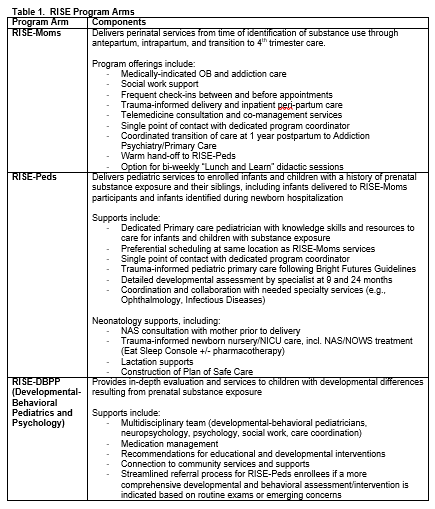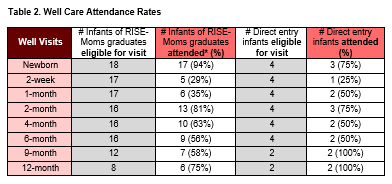General Pediatrics: All Areas
General Pediatrics 1
113 - Delivery Outcomes and Health Services Utilization of Neonates/Infants Enrolled in a Dyadic Maternal-Child Substance Exposure Program
Publication Number: 113.114
.jpg)
Tashyana Copeland-Smith, MPH CHES (she/her/hers)
Project Coordinator
UH Rainbow Babies & Children's Hospital
Cleveland, Ohio, United States
Presenting Author(s)
Background:
Increases in maternal opioid use have led to sharp increase in neonatal opioid withdrawal syndrome (NOWS) prevalence and is associated with adverse infant health outcomes such as preterm birth and lower birth weight. In Ohio, marijuana, alcohol and tobacco use during pregnancy present additional challenges. The prevalence of alcohol and tobacco use during pregnancy is higher in Ohio than in the U.S. overall.1
The Rainbow Interdisciplinary Substance Exposure Program (RISE) provides single-site, coordinated healthcare services, and psychosocial support for pregnant persons, their children and families. The program is organized into three enrollment arms: RISE-Moms, RISE-Peds, and RISE-DBPP.
Objective: To identify (1) preliminary delivery outcomes and (2) health services utilization of infants born to mothers participating in the pilot year of an innovative, dyadic program designed for pregnant and parenting persons with a history of substance misuse versus infants identified during newborn hospitalization enrolling directly into the pediatric program component (direct entry).
Design/Methods: Children enroll into the RISE-Peds program via two routes: (1) being a child born to/of a RISE-Moms graduate or (2) direct entry via identification during newborn hospitalization or referral from a clinical caregiver. Patient data is collected in a participant database accessible to the clinical and evaluation teams. Each program month, infant outcomes are abstracted from their chart in the EMR and updated based on delivery information and well-child visits. Abstracted data includes NOWS diagnosis, weight percentile and ED visits that occurred in between visits. Well care attendance is captured from newborn until 12 months.
Results:
Since July 2021, 22 infants have enrolled into RISE-Peds as an infant of a RISE-Moms graduate (n=18) or via direct entry (n=4). Infants in both enrollment paths were of similar gestational age < 38 weeks (77.8% infants of RISE-Moms graduates v. 75% direct entry) and similar average birthweights (2781g v. 2707g). However, 75% of direct entry infants received a NOWS diagnosis v. 17.6% of infants of RISE-Moms graduates.
Eight ED visits have occurred to date between both cohorts. Infants of RISE-Moms graduates tended to have slightly higher attendance rates for well care visits.
Conclusion(s): The RISE program is a promising approach to maternal-child dyadic care. Well-coordinated early intervention for both mother and child, starting as early as in utero, can be beneficial in supporting positive delivery outcomes and promoting health care utilization for infants/children exposed to substances.

